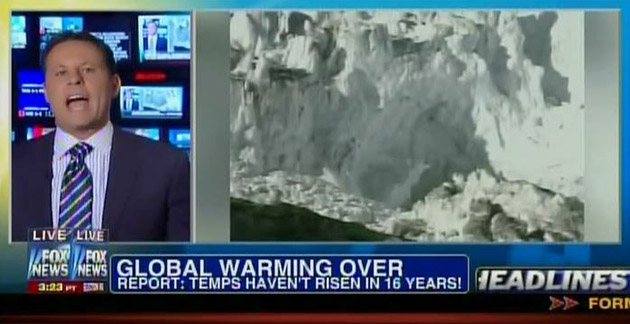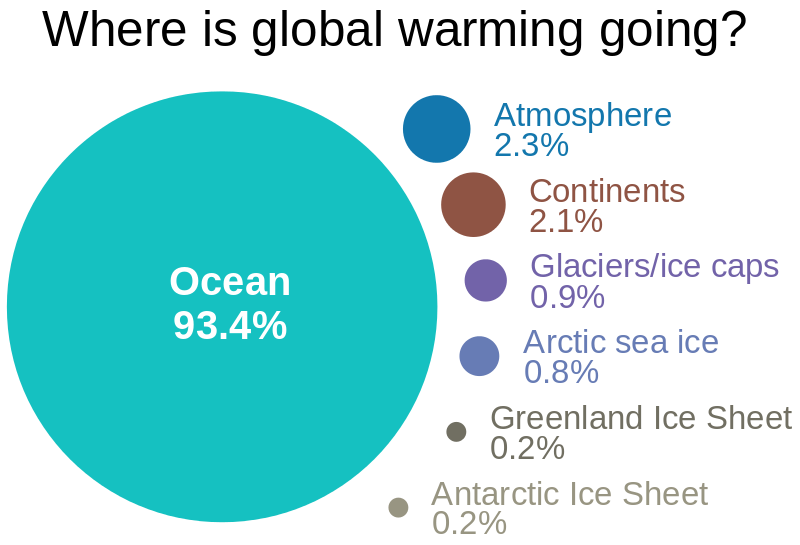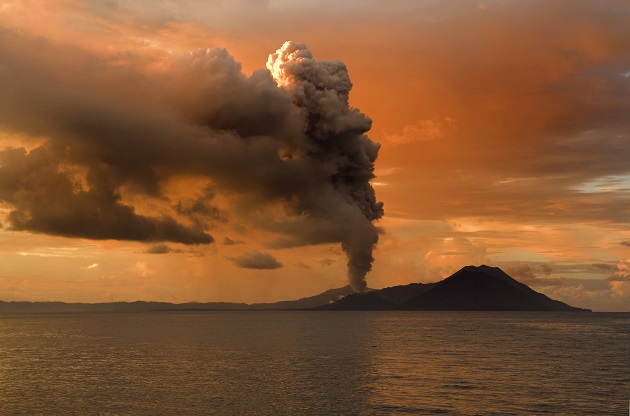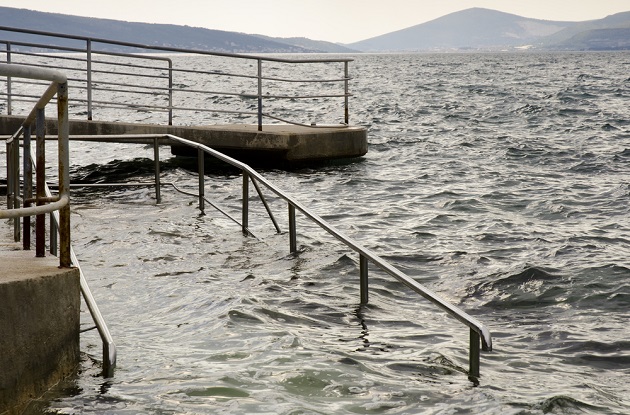
Fox News in October 2012. Screenshot: <a href="http://mediamatters.org/blog/2012/12/31/10-dumbest-things-fox-said-about-climate-change/191859">Media Matters</a>/Fox News
Chances are you’ve heard people say that global warming has “stopped,” “paused,” or hit a “slowdown.” It’s a favorite talking point of political conservatives like Texas Sen. Ted Cruz, who recently declared that there has been “no recorded warming since 1998.” Climate skeptics frequently use these arguments to cast doubt on climate science and to downplay the urgency of addressing global warming. Last year, for instance, Fox News pronounced global warming “over.”
Scientists disagree. It’s true that they also acknowledge the slowdown: A new paper just out in the prestigious journal Nature, for instance, cites the “hiatus in global warming” and seeks to explain it with reference to changes in the tropical Pacific. The recently leaked Intergovernmental Panel on Climate Change (IPCC) report, too, cites an “observed reduction in surface warming.” But scientists say the slowdown is only temporary—a result of naturally induced climate variability that will soon tip back in the other direction—and that more human-caused global warming is on the way.
So who’s right? Here’s what you need to know about the slowdown, why it’s happening, and why the threat of global warming is still very real:
Have temperatures really stopped rising? Not exactly. First, “global warming” never meant that temperatures increase relentlessly, year after year—it’s more complicated than that.
“There’s always more than one thing going on in the climate system,” explains climate researcher Jerry Meehl of the National Center for Atmospheric Research in Boulder, Colorado. There are really hot years and there are less hot years. But since the 1950s, each successive decade has been hotter than the last, according to the World Meteorological Organization, and the 2000s were the warmest decade “since the start of modern measurements in 1850.”
Okay, so it’s clearly misleading to say the planet has stopped warming. What’s actually going on? It’s pretty nuanced: According to the leaked IPCC draft report, the rate of warming at the planet’s surface (technically, the “global mean surface temperature”) is lower over the last 15 years, kind of like a car easing off the accelerator. The draft states that the rate of surface warming from 1998-2012 was 0.05 degrees Celsius per decade. But over the entire period from 1951 to 2012, it was 0.12 degrees Celsius per decade. (Keep in mind that not every aspect of the climate system necessarily reflects this “slowdown”: Arctic sea ice, for instance, hit a record low in 2007 and then another record low in 2012.)
How significant is the surface temperature slowdown in the context of global warming as a whole? The slowdown is certainly big enough to measure—or else we wouldn’t be discussing it—but not a huge deal in the context of the climate system. That’s because surface temperature itself, while a useful measurement, only captures a small part of what’s actually happening to the planet.

At present, the Earth has an “energy imbalance“—because of heat-trapping greenhouse gases, more heat is arriving from the sun than is escaping back into space again—and that heat simply has to go somewhere. The question is where. When people think about global warming, they often think about air temperature—where the slowdown is most pronounced—but the truth is that only a tiny percentage of the excess heat actually ends up in the atmosphere. The biggest heat “sink,” by far, is the world ocean. Ninety-three percent of the planet’s excess energy gets swallowed up by the blue, according to the IPCC.
Other repositories of heat—glaciers, ice sheets, the land, the atmosphere—all play a much smaller role. So if one of these changes a little, that doesn’t shift the big picture much. “What is being talked about is a small fraction of the energy changing a bit,” explains Michael MacCracken, chief scientist at the Climate Institute and a former Clinton administration climate science official.

Indeed, the oceans—the elephant in the climate system, so to speak—are still warming up. Recent data on the warming of the ocean, published by oceanographer Sydney Levitus of the University of Maryland and his colleagues, suggest an increase in heat content in both the surface layer and also between 700-2,000 meters of depth. “The important thing in terms of climate change is that the world ocean has continued to store heat,” says Levitus. The amount of heat, by the way, is staggering: If the heat stored in the oceans from 1955 to 2010 were all to suddenly go to the atmosphere (which, thankfully, would never happen), Levitus and his colleagues estimate that would translate into a 65-degree Fahrenheit temperature increase!
So what is causing the surface temperature slowdown? Scientists point to multiple causes, including more heat going into the deeper oceans, a recent minimum in solar activity, and more volcanic activity. All of these phenomena could contribute to a temporary slowdown in global warming. “It may very well be that the best explanation is that there is some combination of things that has led to this slowdown,” explains Anthony Broccoli, a climate researcher at Rutgers University.
What is the role of the Pacific Ocean? Perhaps the leading explanation for the slowdown is that the oceans, and particularly the vast Pacific, are storing more heat at depth. That’s the upshot of the new Nature study, and also much other recent work. “Global warming is alive and well,” explains NCAR researcher Kevin Trenberth, “but about 30 percent of the heat is going deeper into the ocean.”
Indeed, Trenberth and climate modeler Jerry Meehl of NCAR recently published a paper that used a climate modeling approach to study global warming “hiatus decades.” They found that in their simulation, such periods not only occur, but when they do, the deep ocean warms up more than either the ocean’s upper layer, or surface air temperatures.
Scientists think they understand the mechanism here: It’s a slow and naturally occurring fluctuation that’s sometimes called the Interdecadal Pacific Oscillation. In one phase of the oscillation, La Niña-like conditions exist in the Pacific, as cool deep water rises to the ocean surface, displacing warmer surface waters, which in turn get buried deeper in the ocean. This process—sometimes called “upwelling”—warms the deep ocean, but simultaneously cools the overlying atmosphere.
In other words, the world’s oceans keep getting warmer, but a temporary cooling of the surface of the Pacific is constraining global surface temperatures—for the time being, anyway.
“You might think of the atmosphere as the tail, and the ocean being the dog, as far as heat is concerned,” explains Rutgers’ Broccoli. “Although the tail may wag around a little, what it’s really doing is following the dog.”
What about volcanoes? Scientists seem increasingly convinced that the oceans are the chief factor behind the slowdown. But there may be other contributing causes as well. One of them is volcanoes—smaller, tropical volcanoes in particular.

It has long been known that dramatic volcanic eruptions, like that of Mount Pinatubo in the Philippines in 1991, have a global cooling effect. They do this by injecting sulfur particles, often called sulfate aerosols, directly into the stratosphere, where they reflect sunlight away from the planet. “Volcanoes are basically attenuating the light between you and the sun,” explains Susan Solomon, a former IPCC co-chair and a climate researcher at MIT.
What’s new is the finding that smaller volcanoes, cumulatively, can have a significant influence on global temperatures. In a 2011 paper in Science, Solomon and her colleagues found that smaller volcanic activity has ticked up recently, and is “reducing the recent global warming that would otherwise have occurred.”
“What I think is very clear is that there has been a big increase in the aerosol loading of the stratosphere from volcanoes that we did not think were energetic or explosive enough,” says Solomon. She doesn’t think that’s enough to explain the slowdown in its entirety, but she does see it as a contributing factor.
What about the sun? And water vapor? At least two more possible contributing factors also arise in scientific conversation. There’s the role of the sun: It too goes through cycles, and from 2005 to 2010, there was “an unusually long solar minimum,” Broccoli says. That may have also lessened global warming a bit. Finally, for reasons that scientists don’t yet understand, the stratosphere seems to have contained less water vapor in the 2000s than it did during the 1990s. Water vapor enhances the greenhouse effect—like carbon dioxide, it’s a greenhouse gas.
Does all of this mean that climate models are wrong? One leading skeptic charge is that the global warming slowdown undermines our trust in the climate models that researchers use to project future temperatures—after all, skeptics say, the models missed the slowdown. And it’s true that climate models have not always adequately included some of the factors discussed above, many of which are naturally occurring and hard to predict. Take volcanoes, for instance. “We don’t try to model volcanoes, we observe them,” Solomon says. “That’s not something you try to predict, ’cause it’s not predictable.”
However, scientists are constantly updating their models based on new data—and one upshot of the new Nature paper is that if recent trends in the Pacific are properly taken into account, climate models can capture the global warming slowdown.
What about claims that the climate is less sensitive than we thought to greenhouse gas emissions? “Climate sensitivity” is a somewhat odd measure—it refers to the amount of warming that would occur once the planet adjusts to a doubling of atmospheric carbon dioxide. Various estimates and ranges are often given for the climate sensitivity, and in the leaked IPCC draft report, it is from 1.5 to 4.5 degrees Celsius. The lower end of the range was adjusted downwards in the draft report, based on new research—but as of now, most scientists don’t think that the slowdown is any indication that the climate system is less sensitive to human influence than previously thought. Rather, they think the slowdown is the result of temporary, natural variations that may soon subside.
“I don’t think we’ve seen anything that represents a paradigm shift in terms of our understanding of climate sensitivity,” Broccoli says.
Does this mean I can worry less about global warming? That’s probably not a good idea. If anything, the fact that the most cited causes of the slowdown are thought to be natural suggests that they’ll end eventually—whereupon global warming will snap back again, and perhaps more intensely than before. After all, the major non-natural factor in the system, human greenhouse gas emissions, will still be there. Or as the new Nature paper puts it: “the recent cooling of the tropical Pacific and hence the current hiatus are probably due to natural internal variability…If so, the hiatus is temporary, and global warming will return when the tropical Pacific swings back to a warm state.”
The IPCC, in its leaked report, acknowledges the global warming slowdown and also cites a 95 percent probability that humans are causing global warming. If the world’s definitive source on climate science doesn’t see any contradiction there…then you probably shouldn’t either.
















